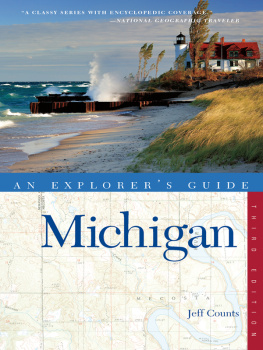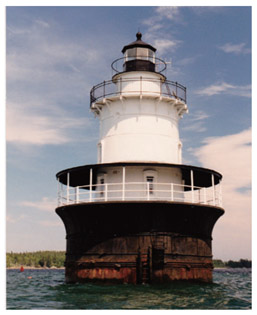ABOU T THE AUT HORS
Bruce Roberts and his wife, Cheryl, live on North Carolinas Outer Banks, not far from the Cape Lookout Lighthouse. For many years Bruce was senior travel photographer for Southern Living magazine. He started his career working as a photographer for newspapers in Tampa, Florida, and Charlotte, North Carolina. He is the recipient of many photography awards, and some of his photos are in the permanent collection of the Smithsonian Institution.
Cheryl Shelton-Roberts has done extensive research on American lighthouses for two decades and has written numerous maritime-themed books including Lighthouse Families, named best lighthouse history book by The Foundation for Coast Guard History in 2007, and most recently North Carolina Lighthouses: Stories of History and Hope in 2011. She wrote the interpretive book Moving Hatteras: Relocating the Cape Hatteras Lighthouse to Safety for the National Park Service after working with move engineers for six months prior to the move. She was awarded the American Lighthouse Foundations Keeper of the Light award in 2001 and saluted as the US Lighthouse Societys Keeper of the Quarter in 2012. She is cofounder of the Outer Banks Lighthouse Society (1995) and creates the societys The Lighthouse News, now in its eighteenth year.
Ray Jones is a historian, author, and publishing consultant living in Pebble Beach, California. He has written more than thirty books on subjects ranging from dinosaurs to country stores but is probably best known for his lighthouse travel guides and histories. Published by Globe Pequot Press in 2004, his award-winning Lighthouse Encyclopedia is widely regarded to be the best and most informative volume on the subject. He has also written a number of PBS companion books, including Niagara Falls: An Intimate Portrait, published in 2006, also by Globe Pequot Press.
ACKNOWLEDGMENTS
Many thanks to those who supplied photography and other help: Rick Polad, Jeremy DEntremont, and Kraig Anderson, whose photography enhanced this edition; Mark Riddick, New Light Photography; William G. Kaufhold; Bob and Sandra Shanklin; Ben Russell; John W. (Jack) Weil; Frank Parks; Daniel J. Gruszka; Dave Kramer; Lamar C. Bevil Jr.; Lee Radzak at Split Rock Lighthouse, who was the perfect lighthouse keeper for my picture; Dick Moehl, president of the Great Lakes Lighthouse Keepers Association; Don Terras of the Grosse Point Lighthouse; the late Ken Black of the Shore Village Museum (now the Maine Lighthouse Museum) in Rockland, Maine; James W. Claflin of Kenrick A. Claflin & Son; Cullen Chambers at Tybee Island Light Station; Dave Snyder, former park historian, Apostle Islands National Lakeshore; Jeanne and George Couglar of the Tibbetts Point Lighthouse; Steve Harrison, historian, Cape Hatteras National Seashore; Tim Harrison of Lighthouse Digest magazine and Lighthouse Depot, for supplying photographs of isolated Maine lights that supplemented my photography; Candace Clifford of the Maritime Initiative; Dane and Judy Alden and Henry Gonzalez for their advice.
A special thanks to Dr. Robert Browning, US Coast Guard historian, for all his assistance in locating old photos and helping with identification of the lights and many other considerations. And appreciation is given to Dr. Laddie Crisp Jr., whose high-definition digital photography equipment so eloquently illustrates the advance in the art and the upside to technology.
The following websites are some of the available, excellent sources of information on lighthouses. As with all sources, check dates any information was recorded for up-to-date details: Jeremy DEntremont, www.lighthouse.cc; Bob Trapani, http://stormheroes.com; Lighthouse Directory, http://unc.edu/~rowlett/lighthouse; Kraig Anderson, www.lighthousefriends.com; US Coast Guard, www.uscg.mil/history; National Park Service Maritime Heritage Program, www.nps.gov/maritime; American Lighthouse Foundation, www.lighthousefoundation.org; Bob DaVia, http://seathelights.com; and on North Carolina lights, www.oblhs.org, where questions on lighthouses are fielded and personally answered by the Outer Banks Lighthouse Society; American Lighthouse Coordinating Committee, http://amlhcc.org/research.htm; United States Lighthouse Society, www.uslhs.org; Terry Pepper and the Great Lakes Lighthouse Keepers Association, www.gllka.com. Additionally, many lighthouses are operated by individual groups that have their own websites, and many are listed in this new edition.
Dates quoted for each light station: The year a light station was established can vary from one to ten years, depending on how long it took to get a clear deed to the land, construct all buildings, and install the light apparatus. Therefore, dates cited in this edition refer to the year a lighthouse was in service and its light operative and are stated as accurately as documentation allows.
We are especially grateful to Erin Turner and Ellen Urban for their invaluable editorial assistance and advice on style.
MAINE
WEST QUODDY HEAD LIGHT
Lubec (1808, 1831, and 1857)
Looking out across the Quoddy Narrows from its perch on a forty-foot cliff, West Quoddy Head lighthouse anchors the easternmost point in the United States (East Quoddy Head Light, across the narrows, is on Canadas Campobello Island). Established in 1808, while Thomas Jefferson was still president, this is one of Maines oldest light stations. The original rubble-stone tower was torn down and rebuilt in 1831, but even this light was of poor construction. Finally, the tower was replaced with a brick one in 1857. At that time the station received the third-order Fresnel lens that still guides ships and fishing vessels into Lubec Channel. The light atop the forty-nine-foot, candy-striped tower flashes white four times each minute and can be seen from a distance of up to eighteen nautical miles.
West Quoddy Head Light
Equipped with a strobe light and an electric eye that sense moisture in the air, the stations powerful foghorn occupies a separate brick building. Earlier fog signals here included a black-powder cannon, a fifteen-hundred-pound bell, and a steam whistle.
Travel information: From US Highway 1 turn toward Lubec on Route 169; then turn right at the sign for Quoddy Head State Park. The state park offers world-class views of Grand Manan Channel, nature trails featuring real tundra, and a chance to walk the lighthouse grounds at leisure. Contact West Quoddy Head Lighthouse and Visitor Center, located at 973 South Lubec Road, Lubec, ME 04652. The visitor center is run by West Quoddy Head Light Keepers Association and is open generally Memorial Day through Columbus Day; call (207) 733-2180, or see www.westquoddy.com.
LUBEC CHANNEL LIGHT
Lubec (1890)
Most vessels approaching the St. Croix River ports of Lubec, Eastport, and Calais use the narrow Lubec Channel, which separates Maine from Canadas Campobello Island to the north of Quoddy Head. To make this key passage safer, the US government marked it with an open-water light station in 1890. Built on a massive caisson of concrete and iron, the stations brick-lined, cast-iron tower rises fifty-three feet above the water. When seen from a distance, lighthouses of this type resemble giant spark plugs.
Lubec Channel Light
Nick Salata, Lighthouse Digest
In the past hardy keepers and their assistants lived year-round in cramped quarters on the lower level. The station was automated after a destructive oil fire in 1939.










